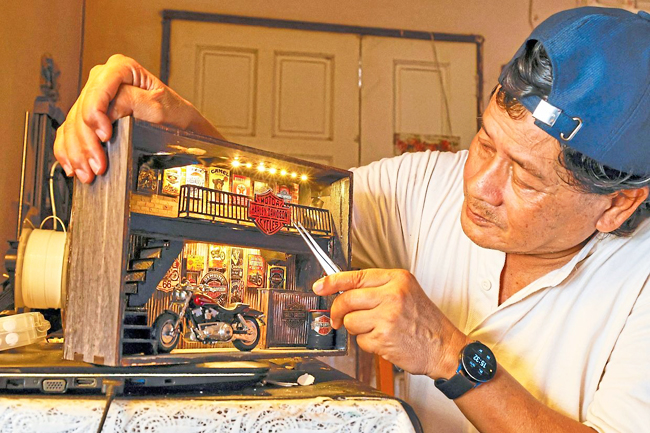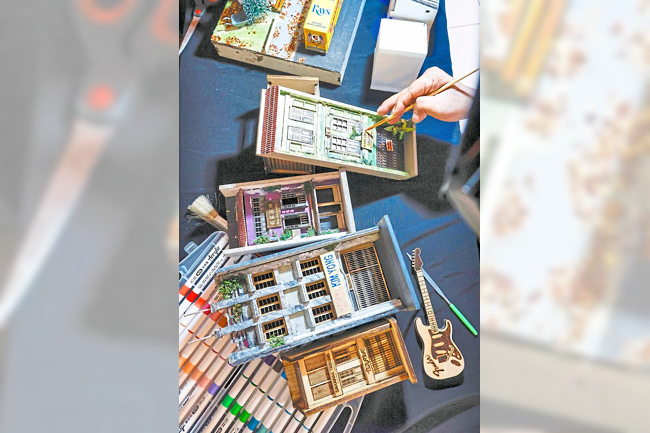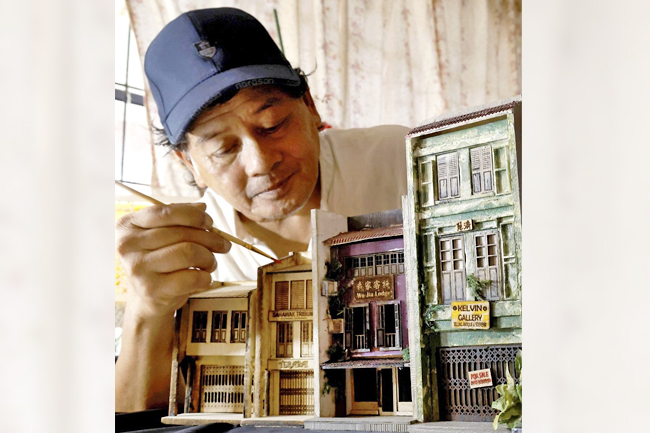ANN/THE STAR – Despite facing multiple health challenges, 62-year-old Zulkifli Sahak remains upbeat and optimistic. Diagnosed with essential thrombocythaemia (a rare blood cancer), kidney failure, and gout, and having undergone heart bypass surgery, the Kuching-based pensioner continues to maintain a positive outlook on life.
“My health issues are beyond my control, but I choose to focus on what I can manage, embrace the positives, and make the most of every moment,” he shared during a recent Zoom interview from his home in Taman Gita Jaya, Petra Jaya, Kuching.
Living with multiple health conditions isn’t easy for the retired technical instructor from Kuching’s Institut Kemahiran Mara (IKM), but Zulkifli refuses to let them define him.
With over 40 years of experience as an arts and crafts trainer at IKM and a background in carpentry, it feels natural for Zulkifli to channel his creativity into crafting intricate dioramas. This hobby has become a way for him to unwind amidst his health challenges.
Dioramas are three-dimensional miniature scenes with detailed backgrounds and life-like effects. They can range in size from small tabletop models to large displays and are often used as teaching aids, entertainment and storytelling tools.
“I create dioramas because they bring me joy and give me a sense of purpose. I learned the craft by watching video tutorials on social media platforms like Facebook, YouTube and Instagram,” said Zulkifli.
In just three years, he has completed over 100 dioramas, many of which are commissioned projects. These include iconic old buildings along Kuching’s Waterfront which overlook the Sarawak river, government buildings and a padi processing plant.
“I was inspired by my love for old buildings, especially the heritage shophouses around the Waterfront area. These buildings hold rich stories from the past. Preserving them is vital to help people appreciate their significance and learn about the history they represent.”




KEEPING THE MIND ACTIVE
The father of three is determined to stay busy in his retirement years, just like former Prime Minister Dr Mahathir Mohamad.
“Look at Tun M. He is still active and mentally sharp at 99. I want to follow in his footsteps by eating healthy and staying fit,” said Zulkifli, who holds a carpentry certificate from Hawthorn Institute of Education in Melbourne, Australia.
In the 1990s, Zulkifli was selected by IKM to attend a sign painting course at Carrington Polytechnic in Auckland, New Zealand.
Research has shown that staying active is crucial for retirees to help them maintain mental sharpness and physical strength.
A 2023 study entitled Active Engagement and Health Status of Older Malaysians: Evidence from a Household Survey states that Malaysians must maintain an active lifestyle to remain independent and enjoy a good quality of life as they age.
The research, published in Pertanika Journals, found that promoting active and healthy ageing is in line with the goals of the National Policy for Older Persons to create opportunities for them to live independently and to enhance their potential so that they remain active and productive contributors in national development.
Zulkifli believes that older adults can stay active and fulfilled by pursuing hobbies they are passionate about, whether it’s cooking, gardening, sewing, travelling or anything else that brings them happiness.
“Find a hobby that sparks your interest and keeps your mind engaged. For me, it is carpentry and diorama-making.
“I love the idea of creating dioramas from scratch. There’s a great sense of pride in transforming raw materials into something both useful and beautiful. It’s pure joy to see my visions come to life,” said Zulkifli, who co-founded Borneo Metal Arts (BMA), a company that produces customised metal posters, with his eldest son Ahmad Nazreen in 2016.
Diorama-making might be relatively new to many in Malaysia, but the community is steadily growing. At Sungei Wang Plaza in Kuala Lumpur, MinNature offers a miniature heritage gallery featuring thousands of replicas that showcase the country’s culture and heritage. There’s also the Facebook group, Diorama & Miniature Malaysia, which has over 15,000 members.
ARTISTIC TOUCH
Several local diorama enthusiasts have also made their mark. Selangor-based sketch artist and photographer Eddie Putera is known for his miniature townhouses and vehicles. There’s also Lim Pui Wan, a former mechanical engineer from Johor Baru, who creates miniature depictions of old sundry shops and kitchens. Ronnie Wong, a septuagenarian from Selangor, specialises in recreating insects in their natural habitats.
Zulkifli picked up dioramas in 2022 as a form of therapy following his heart bypass. During that time, he also took a step back from managing BMA, as he didn’t want to exert himself post-surgery.
“But being an active person, I felt restless around the house. I decided to make diaromas as it seemed interesting. I downloaded a computer-aided software, and bought a 3D mini laser cutting machine for MYR1,000 and started exploring Google and YouTube to learn how to make dioramas.”
He added that his background in carpentry has helped him grasp diorama-making techniques more quickly and efficiently.
“For example, I already know standard measurements for a door or standard table heights and ceiling dimensions. It is easy for me to build things in miniature size.”
Making dioramas involves several key steps. Zulkifli first decides the theme or scene for the diorama, such as a historical event, nature or urban landscape.
Next, he sketches out the layout (using freehand sketching or computer-aided design) and size of the diorama to ensure everything fits together. This process takes Zulkifli about three hours, which helps him determine the overall sizing before moving on to the technical details.
He then builds the base using materials like foam, wood or cardboard to create the foundation. Some items are made using the 3D cutting machine. To create the scene, he sculpts or gathers miniature figures, buildings, trees and other elements. Next, colour and texture are added to bring the scene to life. Lastly, he uses accessories like lights or props to enhance the realism of the projects.
“I like building dioramas because it is like creating a small world where my imagination comes to life.”
Zulkifli carries out his hobby in a makeshift room, measuring four square metres , in a corner of his living room. “It is not a big space but it’s enough to work on my creations.
Here I have my computer, printer, workstation and equipment like acrylic paint, turpentine and paintbrushes. My trusted hand tools include a drill, scissors and a rotary cutter.
“The 3D laser cutting printer is used to precisely cut out shapes for my creations,” said Zulkifli, who makes his dioramas using balsa wood (a soft and light wood commonly used in model-making and crafts), clay, paper and foam board. – Sheela Chandran






